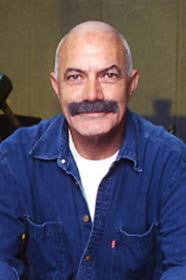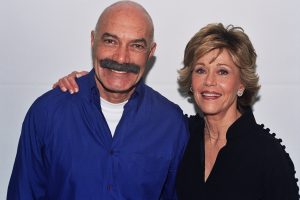In the 1930s, most of the studios produced musicals, each developing its own distinctive style, largely based on the directors and stars under contract at the time.
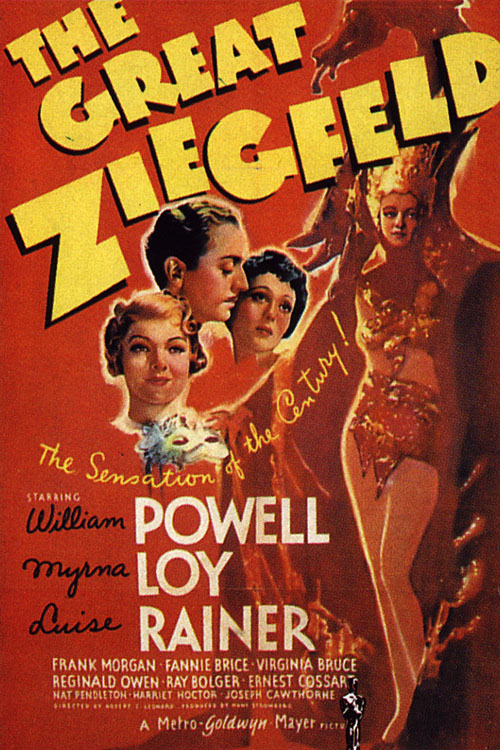
In 1936, MGM was represented in the Oscars race with “The Great Ziegfeld,” which became the second Oscar-winning musical, after “Broadway Melody” (1928-9), and the fourth MGM film to win the Best Picture Oscar, following the all-star melodrama “Grand Hotel” (1932) and the epic adventure, “Mutiny on the Bounty” (1935).
As directed by Robert Z. Leonard, “The Great Ziegfeld” is an overlong (170 minutes) and overblown but ultimately mediocre as a musical movie and as a biopic of the legendary showman.
Fictionalizing the showman’s life, scribe William Anthony McGuire, probably under pressures from his supervisors, whitewashed the narrative, structuring it as a routine rags-to-riches saga, from the times that Flo was a sideshow barker to his becoming Broadway’s most extraordinary impresario, with four simultaneous hits.
The dialogue, based on William Anthony McGuire’s original screenplay, is pedestrian and cliche-ridden. Take Ziegfeld’s line, which concludes the picture: “I’ve got to have more steps. I need more steps. I’ve got to get higher, higher!”
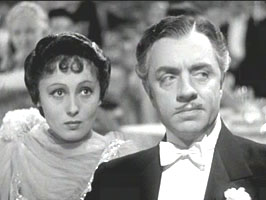 William Powell, who embodied the Broadway producer, was not nominated for an Oscar, perhaps because the role was too shallow for him to leave any imprint. And neither was Myrna Loy, who played Florenz’s second wife, Billie Burke, the actress who was very much alive at the time. (Powell and Loy were very popular in the 1930s with their long-running movie series “The Thin Man,” which made Loy the top box-office star in the country in 1936.)
William Powell, who embodied the Broadway producer, was not nominated for an Oscar, perhaps because the role was too shallow for him to leave any imprint. And neither was Myrna Loy, who played Florenz’s second wife, Billie Burke, the actress who was very much alive at the time. (Powell and Loy were very popular in the 1930s with their long-running movie series “The Thin Man,” which made Loy the top box-office star in the country in 1936.)
Inexplicably, Luise Rainer, a routine actress whom Louis B. Mayer liked, perhaps because of her European pedigree, won the Best Actress Award for playing Ziegfeld’s first, temperamental wife, Anna Held, a role that many considered to be supporting rather lead. (In 1936, the Academy distinguished for the first time between Oscar for lead and secondary roles). One of her few decent scenes has her calling Flo on the phone to congratulate him on his second marriage.
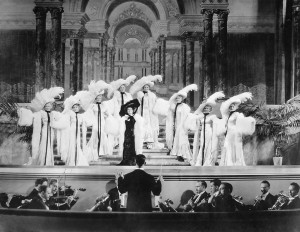 Along the way, there are minor pleasure to be had, though, like some entertaining production numbers, and an eye-popping cast that featured many of Ziegfeld’s real-life stars, such as Fanny Brice, even if her singing of “My Man” is strangely cut before it’s over, Ray Bolger, who would be more entertaining in “The Wizard of Oz,” and Gilda Gray, as well as actors that embodied real-life personages, such as Eddie Cantor and Will Rogers.
Along the way, there are minor pleasure to be had, though, like some entertaining production numbers, and an eye-popping cast that featured many of Ziegfeld’s real-life stars, such as Fanny Brice, even if her singing of “My Man” is strangely cut before it’s over, Ray Bolger, who would be more entertaining in “The Wizard of Oz,” and Gilda Gray, as well as actors that embodied real-life personages, such as Eddie Cantor and Will Rogers.
Detailed Plot
The son of a respected music professor, Florenz “Flo” Ziegfeld, Jr. (William Powell) aims to make his mark in showbiz. He begins by promoting Eugen Sandow (Nat Pendleton), the “world’s strongest man,” at the 1893 Chicago World’s Fair, overcoming competition of rival Billings (Frank Morgan) and his attraction, belly dancer Little Egypt, with savvy marketing.
Ziegfeld returns to his father and young Mary Lou in Leipzig, and departs to San Francisco, where he and Sandow are deemed frauds for putting on a show in which Sandow faces a lion who falls asleep. Flo travels to England on an ocean liner, where he runs into Billings again, who is on his way to sign a contract with the French star Anna Held (Luise Rainer). Despite losing money gambling at Monte Carlo, Flo charms Anna into signing with him instead, pretending he doesn’t know Billings. Anna appreciates his honesty and Ziegfeld promises to give her “more publicity than she ever dreams of” and to feature her with America’s bestl performers.
Ambitious, Flo has ideas for new kind of show featuring women that will “glorify” the American girl. The show, the Ziegfeld Follies, is an opulent production filled with beautiful women and highly extravagant costumes and sets. This smash hit is followed by more versions of the Follies. Ziegfeld tries to make a star out of Audrey Dane (Virginia Bruce) who is alcoholic and lures Fanny Brice (playing herself) away from vaudeville. He gives stagehand Ray Bolger (also playing himself) a big break.
The new production upsets Anna, who realizes that Flo’s world does not revolve around just her, and she becomes envious of his attention to Audrey. She divorces him after walking in on Flo and a drunk Audrey. Audrey then walks out on Flo, now broke, borrows money from Billings for a third new show. Flo meets the Broadway star Billie Burke (Myrna Loy) and soon marries her. When she hears the news, a heartbroken Anna calls Flo and pretends to be glad for him. Flo and Billie eventually have a daughter named Patricia.
Flo’s new shows are a success, but after a while, the public’s taste changes. After a string of negative reviews in the press, Flo overhears three men in a barber’s shop saying that he’ll “never produce another hit.” Stung, he vows to have four hits on Broadway at the same time, a goal he achieves with the hits Show Boat (1927), Rio Rita (1927), Whoope! (1928), and The Three Muskateers. He invests over $1 million in the stock market, and when it crashes in 1929, he is bankrupts, forcing Billie to return to the stage.
Please read review of much superior dramatic musical biopic, Amadeus
Oscar: Amadeus (1984)–Milos Forman’s Second Best Picture Winner
Depressed by growing popularity of movies over live stage shows, he becomes seriously ill. Billings pays him a friendly visit, and the two men become partners in a new, grander production of The Ziegfeld Follies. In the final scene in his apartment overlooking the Ziegfeld Theatre, he recalls scenes from his hits, exclaiming, “I’ve got to have more steps, higher, higher,” before dropping dead.
Cast
William Powell as Florenz Ziegfeld, Jr.
Myrna Loy as Billie Burke.
Luise Rainer as Anna Held.
Frank Morgan as Jack Billings
Fanny Brice as Herself.
Virginia Bruce as Audrey Dane
Reginald Owen as Sampson, Flo’s frequently nervous bookkeeper
Ray Bolger as Himself
Ernest Cossart as Sidney, Billing’s valet, who is hired away by Flo
Joseph Cawthorn as Dr. Ziegfeld (as Joseph Cawthorne)
Nat Pendleton as Eugen Sandow.
Harriet Hoctor as Herself
Jean Chatburn as Mary Lou
Paul Irving as Erlanger, Billing’s later partner
Herman Bing as Costumer.
Buddy Doyle as Eddie Cantor.
Pat Nixon as a Ziegfeld Girl (uncredited)
Mickey Daniels as telegram delivery boy (uncredited)
Dennis Morgan as a vocalist (dubbed by Allan Jones) in the “Pretty Girl” number
OSCAR CONTEXT:
Oscar Nominations
Picture, produced by Hunt Stromberg
Director: Robert Z. Leonard
Original Story: William Anthony McGuire Actress: Luise Rainer
Interior Decoration: Cedric Gibbons, Eddie Imazu, Edwin B. Willis
Film Editing:
Dance Decoration: Seymour Felix
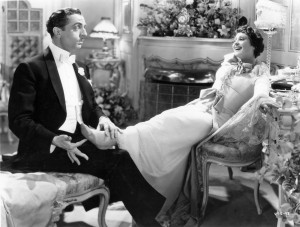 The other most nominated film were William Wyler’s “Dodsworth,” with 7 citations, winning one, for Richard Day’s Interior Decoration, and “Anthony Adverse,” which won the largest number of awards (4) of it 7 nominations. Of all studios, MGM dominated the Oscar race, with five (half) of the Oscar-nominated films.
The other most nominated film were William Wyler’s “Dodsworth,” with 7 citations, winning one, for Richard Day’s Interior Decoration, and “Anthony Adverse,” which won the largest number of awards (4) of it 7 nominations. Of all studios, MGM dominated the Oscar race, with five (half) of the Oscar-nominated films.
The winner of the Directing Oscar was Frank Capra for “Mr. Deeds Goes to Town.” Pierre Collings and Sheridan Gibney won the writing Oscar for “The Story of Louis Pasteur”; Richard Day the Art Direction for “Dodsworth”; and Ralph Dawson the Editing prize for “Anthony Adverse.”







